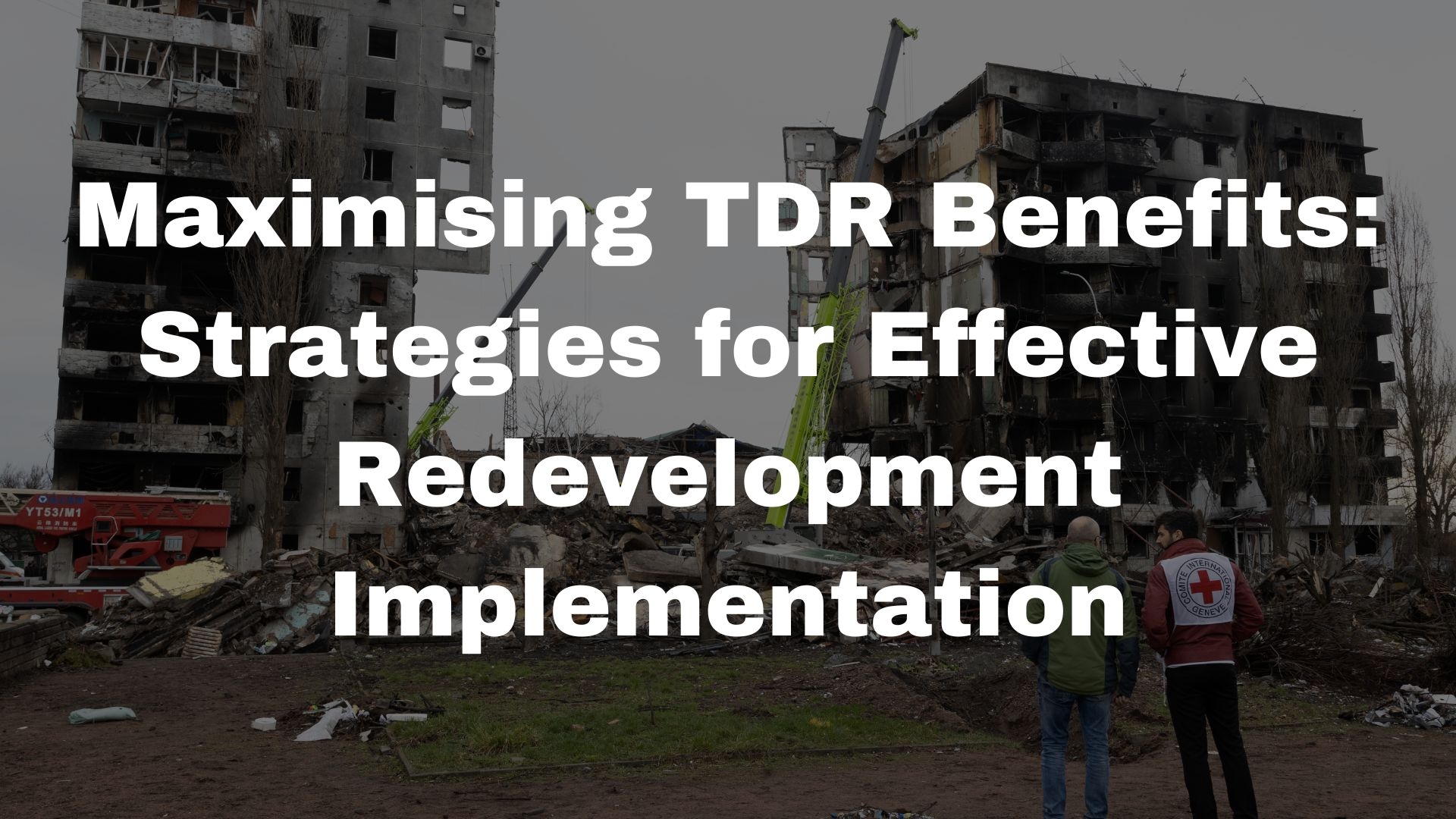
Maximising TDR Benefits: Strategies for Effective Redevelopment Implementation
Transferable Development Rights (TDR) programs are innovative land-use planning tools that balance development and conservation. TDR programs promote sustainable urban development while protecting valuable resources by allowing landowners to transfer development potential from areas designated for preservation to areas suitable for growth.
Understanding Transferable Development Rights (TDR)
At its core, a TDR program involves two primary components:
-
Sending Areas: These are regions identified for preservation, such as agricultural lands, historic sites, or environmentally sensitive zones. Landowners in these areas can sell their development rights, ensuring the land remains undeveloped.
-
Receiving Areas: These are zones designated for increased development density. Developers can purchase development rights from sending areas to build beyond standard zoning restrictions in these locations.
This mechanism creates a market-driven approach where conservation and development interests align.
Importance of TDR Programs
TDR programs offer several benefits:
-
Conservation of Natural and Cultural Resources: By redirecting development away from sensitive areas, TDRs help preserve open spaces, wildlife habitats, and historic landmarks.
-
Promotion of Smart Growth: Encouraging higher-density development in appropriate areas supports efficient infrastructure use and reduces urban sprawl.
-
Economic Incentives: Landowners in sending areas receive financial compensation without developing their land, while developers can build more intensively in the receiving regions.
TDR Implementation in Gujarat
Gujarat has proactively adopted TDR mechanisms to facilitate urban development and conservation. The state's approach to TDR is outlined in the Gujarat Comprehensive Development Control Regulations (GDCR) - 2017, which defines Tradable Development Rights (TDR) as an incentivisation mechanism allowing the transfer of floor space from one building to another.
In 2013, Gujarat introduced the "Comprehensive Development Plan 2021," referring to TDR as "Tradable Development Rights." This initiative aimed to streamline urban development while preserving essential land resources.
Case Law in Gujarat
Various judicial pronouncements have shaped the legal landscape surrounding TDR in Gujarat. One notable case is Synbiotics Ltd. vs Commissioner of Income Tax (1992), where the Gujarat High Court addressed issues related to the taxation of development rights. The court's decision clarified how income from the transfer of development rights should be treated under tax laws.
Strategies for Effective Redevelopment Implementation Using TDR in Gujarat
To maximise the benefits of TDR programs in Gujarat, consider the following strategies:
-
Clear Identification of Sending and Receiving Areas: Conduct comprehensive land-use assessments to accurately designate areas for preservation and development, ensuring alignment with the state's urban planning objectives.
-
Stakeholder Engagement: Involve landowners, developers, community members, and policymakers in the planning process to ensure the program meets diverse needs and garners broad support.
-
Market Analysis: Evaluate real estate market conditions to set appropriate values for development rights and ensure the program's economic viability.
-
Regulatory Support: Establish clear legal frameworks and zoning ordinances that facilitate TDR transactions and provide certainty for participants.
-
Monitoring and Evaluation: Implement systems to track the program's outcomes, allowing for adjustments and improvements over time.
Closing Note
Transferable Development Rights programs are powerful tools for achieving sustainable development and conservation goals. By thoughtfully implementing TDR strategies, Gujarat can balance growth with preserving valuable natural and cultural resources.
In case of any query regarding Maximising TDR Benefits: Strategies for Effective Redevelopment Implementation, feel free to connect with our legal experts, Tulja Legal, at +91 96380-69905
About the Author
Anju S Nair
Legal Researcher | LLB, MA English| Corporate Lawyer | Business Enthusiast | Founder & CEO at iLawbook.
FAQs
-
What is a Transferable Development Right (TDR)?
A TDR allows landowners to sell their property's development potential to another party, separating the right to develop from the land itself.
-
How do TDR programs benefit landowners in sending areas?
Landowners receive financial compensation for selling their development rights while retaining ownership and preserving the land's current use.
-
What incentives do developers have to participate in TDR programs?
Developers can acquire additional development capacity in designated receiving areas, allowing for projects that exceed standard zoning limitations.
-
Can TDR programs be used to preserve historic buildings?
Yes, TDRs are effective in historic preservation. They enable owners of landmark properties to sell development rights and fund maintenance and protection efforts.
-
What challenges might arise in implementing a TDR program?
Challenges include ensuring a balanced market for development rights, aligning stakeholder interests, and establishing clear regulatory frameworks.
-
Are TDR programs applicable in rural areas?
Absolutely. TDRs can preserve agricultural lands and natural habitats by transferring development pressures to more suitable locations.
-
How do TDR programs interact with existing zoning laws?
TDR programs work within or alongside existing zoning regulations, providing a mechanism to modify development densities without traditional rezoning.
-
What role do local governments play in TDR programs?
Local governments design and oversee TDR programs, including designating sending and receiving areas and facilitating transactions.
-
Can TDR programs address affordable housing needs?
Yes, some TDR programs incentivise affordable housing development by allowing increased densities in exchange for such projects.
-
How is the value of a development right determined?
The value is typically based on market conditions, considering land use, location, and allowable densities.
References
-
Gujarat Comprehensive Development Control Regulations – 2017 gujrera.gujarat.gov.in/resources/staticpage/FINAL_Comprehencive_GDCR.pdf
-
TDR Implementation in Gujarat udd.gujarat.gov.in
-
Gujarat State Petronet Ltd. vs. Commissioner of Income Tax (2019) Synbiotics Ltd. vs Commissioner Of Income Tax on 24 August 1992
-
Comprehensive Development Plan 2021," referring to TDR as "Tradable Development Rights Comprehensive Development Plan 2021
